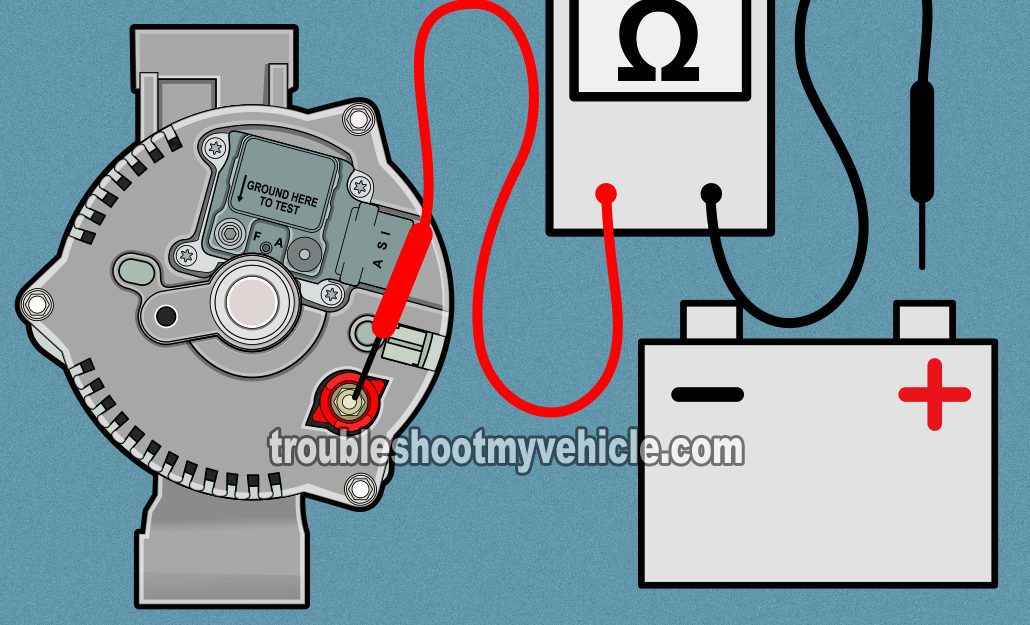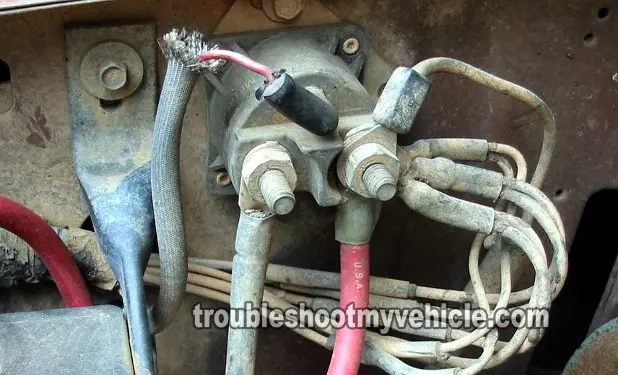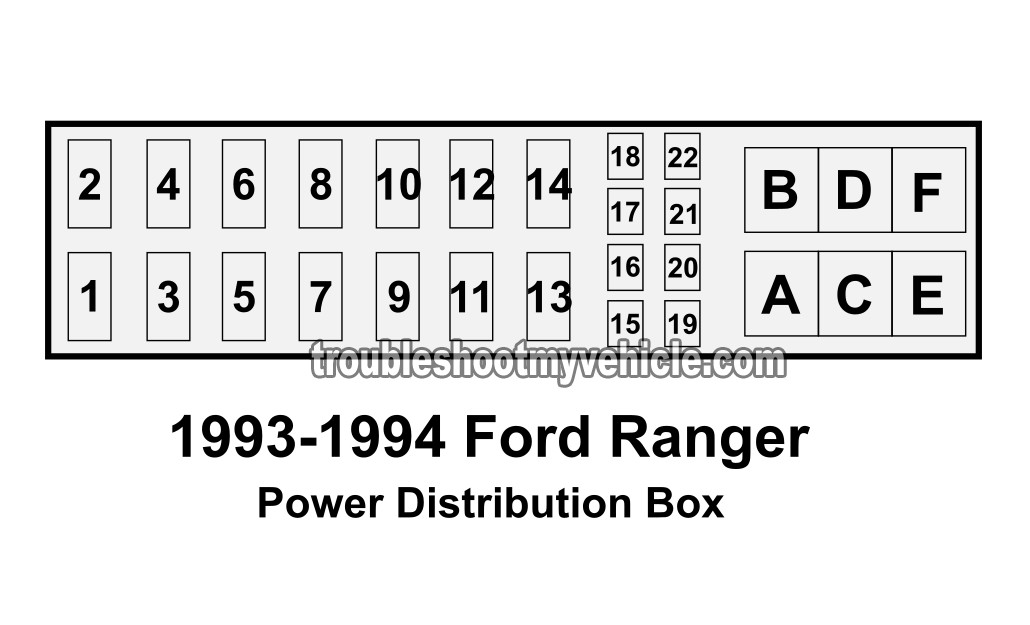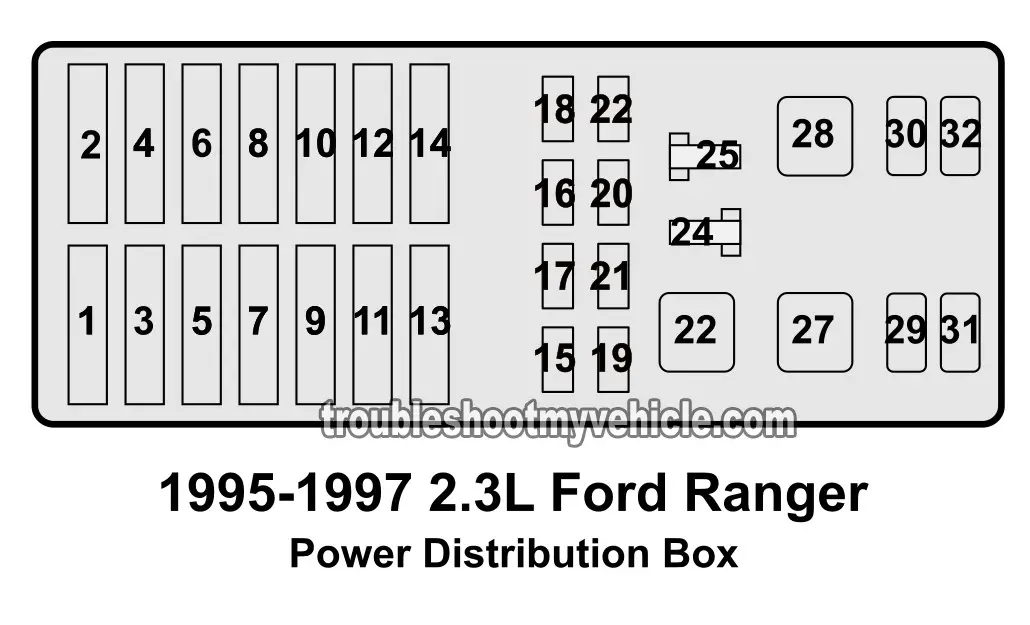TEST 2: Checking The Continuity Of The Bat (+) Cable
You're probably already aware that your 2.3L Ford Ranger's alternator has one heavy gauge wire that connects to the battery's positive (+) post across an inline fusible link.
This fusible link is a 12 gauge inline fusible link and is part of this wire and connects to the starter relay that is bolted to your Ford Rangers inner fender (in the engine compartment, see photo 2 in the image viewer).
All of the electrical power/current that the alternator produces, to charge the battery and to power any of your 2.3L Ford Ranger's electrical needs, passes across this inline fusible link and sometimes this inline fusible link gets blown.
So in this test step, you're going to verify that this inline fusible link is OK (not blown). The fastest/easiest way for you to do this is by doing a simple continuity test.
This is what you'll need to do:
- 1
Disconnect the battery negative (-) cable terminal from the battery negative post. The positive cable remains connected.
IMPORTANT: Don't continue to the next step without first disconnecting the negative cable from the negative battery post. - 2
After disconnecting the battery negative (-) cable, turn on your multimeter and select Ohms mode.
- 3
Your 2.3L Ford Ranger's alternator has only one big wire attached to it. This wire is attached with a nut. So, place your multimeter's RED test lead on the stud to which this wire is connected to.
See image 1 in the image viewer above. - 4
With the black multimeter test lead, probe the center of the battery positive post on your 2.3L Ford Ranger's battery.
- 5
You'll get one of two results.
1.) If the 12 gauge inline fusible link, protecting this circuit, is blown, your multimeter will indicate a reading of OL (which means over limit). In other words, there will be NO continuity.
2.) If the 12 gauge inline fusible link is OK and not blown, your multimeter will register an Ohms reading of 0.5 Ohms or less. In other words, there will be continuity.
Let's take a look at what your results mean:
CASE 1: Your multimeter registered continuity. This is good, since it indicates that the 12 gauge inline fusible link (that connects to the starter relay) is OK and letting the alternator's output pass to the battery positive post.
You can move on to the last test, which is checking the alternator fuse in the under-hood fuse box of your 2.3L Ford Ranger (this under-hood fuse box is known, in Ford tech speak, as the power distribution box). For this test, go to: TEST 3: Checking The Alternator Fuse.
CASE 2: Your multimeter DID NOT register continuity. This result tells you that the 12 gauge inline fusible link is blown and this is keeping the alternator's output from reaching the battery.
Your next step is to replace this inline fusible link with another and retest. Replacing the 12 gauge inline fusible link (if it's blown) should solve your No Charge condition. You'll have to investigate the reason this inline fusible link blew, since they don't get blown for no particular reason.
TEST 3: Checking The Alternator Fuse
If you've reached this point, you have: One, confirmed that the battery's voltage is at or below 12.5 Volts (with the engine running that is).
Two, the 12 gauge inline fusible link, that connects to the starter relay, is not blown.
The next step (and the last one), before concluding that the alternator has failed, is to check the alternator fuse that's located in the under-hood fuse box (this under-hood fuse box is also known as the power distribution box).
Depending on the year of your particular 2.3L Ford Ranger, this fuse is located in a different spot on the power distribution box.
Here are the specific locations, depending on the year of your particular 2.3L Ford Ranger:
- 1993 Ford Ranger: 15 Amp fuse. Number 16 (image 1 of 2).
- 1994 Ford Ranger: 15 Amp fuse. Number 20 (image 1 of 2).
- 1995-96 Ford Ranger: 15 Amp mini-fuse. Number 17 (image 2 of 2).
- 1997 Ford Ranger: 15 Amp mini-fuse. Number 16 (image 2 of 2).
NOTE: You can enlarge the illustrations in the image viewer to get a good view of the location of the alternator fuse location.
This is what you need to do:
- 1
Reconnect the battery to its battery negative (-) cable, that you disconnected in the previous test.
- 2
Locate the alternator fuse, which will be located in the under-hood fuse/relay box your 2.3L Ford Ranger using one of the 2 illustrations in the image viewer above.
- 1993 Ford Ranger: 15 Amp fuse. Number 16 (image 1 of 2).
- 1994 Ford Ranger: 15 Amp fuse. Number 20 (image 1 of 2).
- 1995-96 Ford Ranger: 15 Amp mini-fuse. Number 17 (image 2 of 2).
- 1997 Ford Ranger: 15 Amp mini-fuse. Number 16 (image 2 of 2).
- 3
Once you have located the alternator fuse, remove it and check that it's not blown.
- 4
If it is blown, replace it with a new one and repeat TEST 1.
Let's take a look at what your test results mean:
CASE 1: The alternator fuse is NOT blown. This is good and let's you know that the alternator has all of the power sources it needs to charge, since it isn't, this result also let's you know that the alternator is bad and needs to be replaced.
CASE 2: The alternator fuse IS blown. Replace the fuse with another of the same amperage rating (15 amps) and start the engine and check to see if the alternator is now charging the battery by repeating TEST 1.





